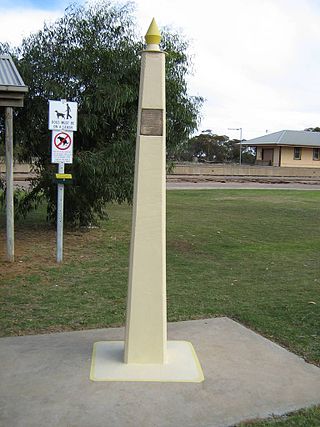
A meteorite is a rock that originated in outer space and has fallen to the surface of a planet or moon. When the original object enters the atmosphere, various factors such as friction, pressure, and chemical interactions with the atmospheric gases cause it to heat up and radiate energy. It then becomes a meteor and forms a fireball, also known as a shooting star; astronomers call the brightest examples "bolides". Once it settles on the larger body's surface, the meteor becomes a meteorite. Meteorites vary greatly in size. For geologists, a bolide is a meteorite large enough to create an impact crater.

The Wold Cottage meteorite fell near Wold Cottage farm in 1795, a few miles away from the village of Wold Newton in Yorkshire, England.

The Cape York meteorite, also known as the Innaanganeq meteorite, is one of the largest known iron meteorites, classified as a medium octahedrite in chemical group IIIAB. In addition to many small fragments, at least eight large fragments with a total mass of 58 tonnes have been recovered, the largest weighing 31 tonnes. The meteorite was named after Cape York, a prominent geographic feature located approximately 30 miles (48 km) west of the east coast of Meteorite island and the nearby peninsulas in northern Melville Bay, Greenland, where the first meteorite fragments were discovered.

Mesosiderites are a class of stony–iron meteorites consisting of about equal parts of metallic nickel-iron and silicate. They are breccias with an irregular texture; silicates and metal occur often in lumps or pebbles as well as in fine-grained intergrowths. The silicate part contains olivine, pyroxenes, and Ca-rich feldspar and is similar in composition to eucrites and diogenites.

A meteorite fall, also called an observed fall, is a meteorite collected after its fall from outer space was observed by people or automated devices. Any other meteorite is called a "find". There are more than 1,300 documented falls listed in widely used databases, most of which have specimens in modern collections. As of February 2023, the Meteoritical Bulletin Database had 1372 confirmed falls.

The Karoonda meteorite is a meteorite that fell to earth on 25 November 1930 at 10:53 pm near the South Australian town of Karoonda. It is of a rare composition, being carbonaceous chondrite, and is also rare in that it was found so soon after its landing. Several fragments are now held in the South Australian Museum in Adelaide.
The Carancas impact event refers to the fall of the Carancas chondritic meteorite on September 15, 2007, near the village of Carancas in Peru, close to the Bolivian border and Lake Titicaca. The impact created a small crater in the clay soil and scorched earth around its location. A local official, Marco Limache, said that "boiling water started coming out of the crater, and particles of rock and cinders were found nearby", as "fetid, noxious" gases spewed from the crater. Surface impact occurred above 3,800 metres (12,500 ft).
Mineo was one of the only four witnessed fall pallasite meteorites in the world, and the only one from Italy.

Pultusk is an H5 ordinary chondrite meteorite which fell on 30 January 1868 in Poland near the town of Pułtusk. The event has been known as the stony meteorite shower with the largest number of pieces yet recorded in history. Made up of rocky debris, it consists of pyroxene or olivine chondrules deployed in massive plagioclase. Kamacite is also reported.

Park Forest is an L5 chondrite meteorite that fell on 26 March 2003 in Illinois, United States.

Albareto is a meteorite which in July 1766 fell near the frazione Albareto, of Modena, Emilia-Romagna, Italy.

Bassiknou or Bassikounou is a town and commune in the Hodh Ech Chargui Region of south-eastern Mauritania.

Enstatite chondrites are a rare form of meteorite, rich in the mineral enstatite. Only about 200 E-Type chondrites are currently known, comprising about 2% of the chondrites that fall on Earth. There are two main subtypes: EH and EL, classified based on their iron content.

Chergach is a meteorite found at southwest of El Mokhtar, Erg Chech, Timbuktu district, Mali. It fell on 2 or 3 July 2007, in daytime, and was composed of ordinary chondrite (H5).
Lac Dodon is an iron meteorite discovered by Roland Octerneau of Montreal on rural private property near Lac Dodon, Saint-Calixte, Quebec.
Veliky Ustyug is a pseudometeorite that fell on July 3, 1290 in Kotovo village, near the town of Veliky Ustyug, Vologda Oblast, Russia. The fall was witnessed by local priests. The event was later described in the Life of Procopius the Righteous.
Benton is a meteorite found near the village of Benton, New Brunswick following a fireball. Two masses were found but the meteorites were split up. The largest fragment is now in the Canadian National Meteorite Collection, Ottawa.

Acapulcoites are a group of the primitive achondrite class of stony meteorites.

Fifteen pieces of the Kainsaz meteorite were seen to fall near Kainsaz, Muslyumovo, Tatarstan on September 13, 1937. The largest weighed 102.5 kilograms (226 lb), the total weight was ~200 kilograms (440 lb). As of January 2013 pieces were on sale for ~US$100/g. Kainsaz is the only observed fall in Tatarstan.














